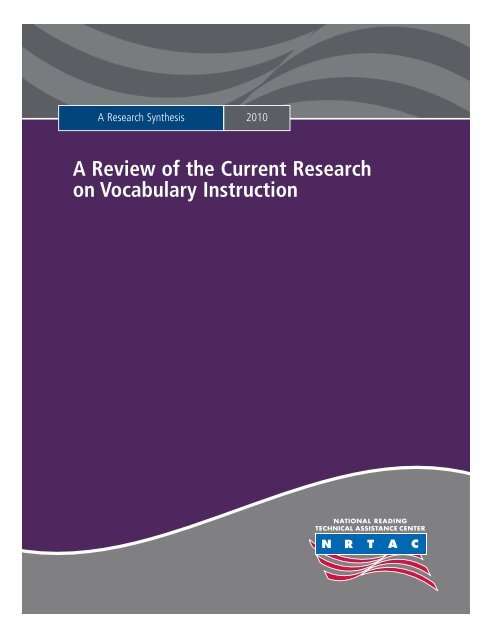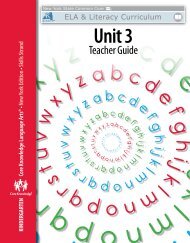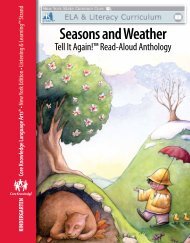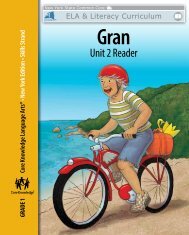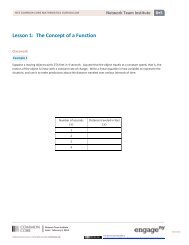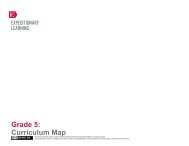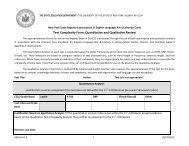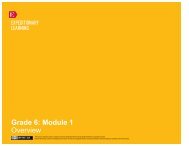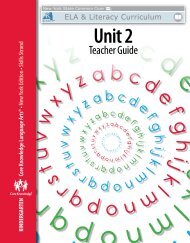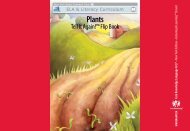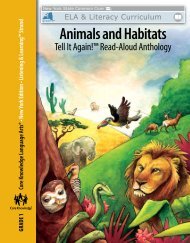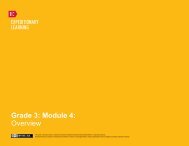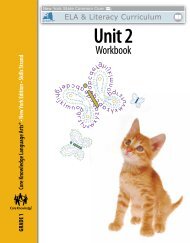A Review of the Current Research on Vocabulary Instruction - U.S. ...
A Review of the Current Research on Vocabulary Instruction - U.S. ...
A Review of the Current Research on Vocabulary Instruction - U.S. ...
You also want an ePaper? Increase the reach of your titles
YUMPU automatically turns print PDFs into web optimized ePapers that Google loves.
A <str<strong>on</strong>g>Research</str<strong>on</strong>g> Syn<str<strong>on</strong>g>the</str<strong>on</strong>g>sis 2010<br />
A <str<strong>on</strong>g>Review</str<strong>on</strong>g> <str<strong>on</strong>g>of</str<strong>on</strong>g> <str<strong>on</strong>g>the</str<strong>on</strong>g> <str<strong>on</strong>g>Current</str<strong>on</strong>g> <str<strong>on</strong>g>Research</str<strong>on</strong>g><br />
<strong>on</strong> <strong>Vocabulary</strong> Instructi<strong>on</strong>
A RESEARCH SYNTHESIS<br />
A <str<strong>on</strong>g>Review</str<strong>on</strong>g> <str<strong>on</strong>g>of</str<strong>on</strong>g> <str<strong>on</strong>g>the</str<strong>on</strong>g> <str<strong>on</strong>g>Current</str<strong>on</strong>g> <str<strong>on</strong>g>Research</str<strong>on</strong>g><br />
<strong>on</strong> <strong>Vocabulary</strong> Instructi<strong>on</strong><br />
This document was compiled, written, and edited by Shari Butler, Kelsi Urrutia, Anneta Buenger,<br />
Nina G<strong>on</strong>zalez, Marla Hunt, and Corinne Eisenhart.<br />
Developed by <str<strong>on</strong>g>the</str<strong>on</strong>g> Nati<strong>on</strong>al Reading Technical Assistance Center, RMC <str<strong>on</strong>g>Research</str<strong>on</strong>g> Corporati<strong>on</strong><br />
The NRTAC expresses its appreciati<strong>on</strong> to Elizabeth Goldman, C. Ralph Adler, and Robert Kozman<br />
<str<strong>on</strong>g>of</str<strong>on</strong>g> RMC <str<strong>on</strong>g>Research</str<strong>on</strong>g> Corporati<strong>on</strong> for <str<strong>on</strong>g>the</str<strong>on</strong>g>ir editorial and producti<strong>on</strong> support. Original design by<br />
Lisa T. No<strong>on</strong>is.<br />
2010
This document was developed by <str<strong>on</strong>g>the</str<strong>on</strong>g><br />
Nati<strong>on</strong>al Reading Technical Assistance<br />
Center. The document was produced<br />
under U.S. Department <str<strong>on</strong>g>of</str<strong>on</strong>g> Educati<strong>on</strong><br />
C<strong>on</strong>tract No. ED-08-CO-0123 with<br />
RMC <str<strong>on</strong>g>Research</str<strong>on</strong>g> Corporati<strong>on</strong>. The views<br />
expressed herein do not necessarily<br />
represent <str<strong>on</strong>g>the</str<strong>on</strong>g> policies <str<strong>on</strong>g>of</str<strong>on</strong>g> <str<strong>on</strong>g>the</str<strong>on</strong>g> U.S.<br />
Department <str<strong>on</strong>g>of</str<strong>on</strong>g> Educati<strong>on</strong>. No <str<strong>on</strong>g>of</str<strong>on</strong>g>ficial<br />
endorsement by <str<strong>on</strong>g>the</str<strong>on</strong>g> U.S. Department <str<strong>on</strong>g>of</str<strong>on</strong>g><br />
Educati<strong>on</strong> <str<strong>on</strong>g>of</str<strong>on</strong>g> any product, commodity,<br />
service, or enterprise is intended or<br />
should be inferred.<br />
http://www.ed.gov/programs/readingfirst/<br />
support/index.html
C<strong>on</strong>tents<br />
Introducti<strong>on</strong> 1<br />
Methodology 3<br />
Database 3<br />
Analysis 3<br />
Results 3<br />
Frequency <str<strong>on</strong>g>of</str<strong>on</strong>g> exposure to targeted vocabulary words 4<br />
Explicit instructi<strong>on</strong> <str<strong>on</strong>g>of</str<strong>on</strong>g> targeted vocabulary words 4<br />
Questi<strong>on</strong>ing and language engagement 5<br />
C<strong>on</strong>clusi<strong>on</strong>s 7<br />
Appendix 9<br />
Studies reviewed for this syn<str<strong>on</strong>g>the</str<strong>on</strong>g>sis 11<br />
References 17
Introducti<strong>on</strong><br />
The Nati<strong>on</strong>al Reading Panel (NICHD, 2000) identified vocabulary as <strong>on</strong>e <str<strong>on</strong>g>of</str<strong>on</strong>g> five major comp<strong>on</strong>ents <str<strong>on</strong>g>of</str<strong>on</strong>g> reading. Its<br />
importance to overall school success and more specifically to reading comprehensi<strong>on</strong> is widely documented (Baker,<br />
Simm<strong>on</strong>s, & Kame’enui, 1998; Anders<strong>on</strong> & Nagy, 1991). The Nati<strong>on</strong>al Reading Panel (NRP) stated that vocabulary<br />
plays an important role both in learning to read and in comprehending text: readers cannot understand text<br />
without knowing what most <str<strong>on</strong>g>of</str<strong>on</strong>g> <str<strong>on</strong>g>the</str<strong>on</strong>g> words mean. “Teaching vocabulary will not guarantee success in reading, just<br />
as learning to read words will not guarantee success in reading. However, lacking ei<str<strong>on</strong>g>the</str<strong>on</strong>g>r adequate word<br />
identificati<strong>on</strong> skills or adequate vocabulary will ensure failure” (Biemiller, 2005).<br />
<strong>Vocabulary</strong> is generically defined as <str<strong>on</strong>g>the</str<strong>on</strong>g> knowledge <str<strong>on</strong>g>of</str<strong>on</strong>g> words and word meanings. More specifically, we use<br />
vocabulary to refer to <str<strong>on</strong>g>the</str<strong>on</strong>g> kind <str<strong>on</strong>g>of</str<strong>on</strong>g> words that students must know to read increasingly demanding text with<br />
comprehensi<strong>on</strong> (Kamil & Hiebert, 2005). It is something that expands and deepens over time.<br />
The NRP’s syn<str<strong>on</strong>g>the</str<strong>on</strong>g>sis <str<strong>on</strong>g>of</str<strong>on</strong>g> vocabulary research identified eight findings that provide a scientifically based<br />
foundati<strong>on</strong> for <str<strong>on</strong>g>the</str<strong>on</strong>g> design <str<strong>on</strong>g>of</str<strong>on</strong>g> rich, multifaceted vocabulary instructi<strong>on</strong>. The findings are:<br />
• Provide direct instructi<strong>on</strong> <str<strong>on</strong>g>of</str<strong>on</strong>g> vocabulary words for a specific text. Anders<strong>on</strong> and Nagy (1991)<br />
pointed out “<str<strong>on</strong>g>the</str<strong>on</strong>g>re are precise words children may need to know in order to comprehend particular less<strong>on</strong>s<br />
or subject matter.”<br />
• Repetiti<strong>on</strong> and multiple exposures to vocabulary items are important. Stahl (2005) cauti<strong>on</strong>ed<br />
against “mere repetiti<strong>on</strong> or drill <str<strong>on</strong>g>of</str<strong>on</strong>g> <str<strong>on</strong>g>the</str<strong>on</strong>g> word,” emphasizing that vocabulary instructi<strong>on</strong> should provide students<br />
with opportunities to encounter words repeatedly and in a variety <str<strong>on</strong>g>of</str<strong>on</strong>g> c<strong>on</strong>texts.<br />
• <strong>Vocabulary</strong> words should be those that <str<strong>on</strong>g>the</str<strong>on</strong>g> learner will find useful in many c<strong>on</strong>texts. Instructi<strong>on</strong><br />
<str<strong>on</strong>g>of</str<strong>on</strong>g> high-frequency words known and used by mature language users can add productively to an individual’s<br />
language ability (Beck, McKeown, & Kucan, 2002). <str<strong>on</strong>g>Research</str<strong>on</strong>g> suggests that vocabulary learning follows a<br />
developmental trajectory (Biemiller, 2001).<br />
• <strong>Vocabulary</strong> tasks should be restructured as necessary. “Once students know what is expected <str<strong>on</strong>g>of</str<strong>on</strong>g> <str<strong>on</strong>g>the</str<strong>on</strong>g>m<br />
in a vocabulary task, <str<strong>on</strong>g>the</str<strong>on</strong>g>y <str<strong>on</strong>g>of</str<strong>on</strong>g>ten learn rapidly” (Kamil, 2004).<br />
• <strong>Vocabulary</strong> learning is effective when it entails active engagement that goes bey<strong>on</strong>d<br />
definiti<strong>on</strong>al knowledge. Stahl and Kapinus (2001) stated, “When children ‘know’ a word, <str<strong>on</strong>g>the</str<strong>on</strong>g>y not <strong>on</strong>ly<br />
know <str<strong>on</strong>g>the</str<strong>on</strong>g> word’s definiti<strong>on</strong> and its logical relati<strong>on</strong>ship with o<str<strong>on</strong>g>the</str<strong>on</strong>g>r words, <str<strong>on</strong>g>the</str<strong>on</strong>g>y also know how <str<strong>on</strong>g>the</str<strong>on</strong>g> word<br />
functi<strong>on</strong>s in different c<strong>on</strong>texts.”<br />
• Computer technology can be used effectively to help teach vocabulary. Encouragement exists but<br />
relatively few specific instructi<strong>on</strong>al applicati<strong>on</strong>s can be gleaned from <str<strong>on</strong>g>the</str<strong>on</strong>g> research (NICHD, 2000).<br />
1
• <strong>Vocabulary</strong> can be acquired through incidental learning. Reading volume is very important in terms<br />
<str<strong>on</strong>g>of</str<strong>on</strong>g> l<strong>on</strong>g-term vocabulary development (Cunningham & Stanovich, 1998). In later work, Cunningham (2005)<br />
fur<str<strong>on</strong>g>the</str<strong>on</strong>g>r recommended structured read-alouds, discussi<strong>on</strong> sessi<strong>on</strong>s and independent reading experiences at<br />
school and home to encourage vocabulary growth in students.<br />
• Dependence <strong>on</strong> a single vocabulary instructi<strong>on</strong> method will not result in optimal learning<br />
(NICHD, 2000).<br />
Stahl (2005) stated, “<strong>Vocabulary</strong> knowledge is knowledge; <str<strong>on</strong>g>the</str<strong>on</strong>g> knowledge <str<strong>on</strong>g>of</str<strong>on</strong>g> a word not <strong>on</strong>ly implies a definiti<strong>on</strong>,<br />
but also implies how that word fits into <str<strong>on</strong>g>the</str<strong>on</strong>g> world.” C<strong>on</strong>sequently, researchers and practiti<strong>on</strong>ers alike seek to<br />
identify, clarify, and understand what it means for students “to know what a word means.” The sheer complexity<br />
<str<strong>on</strong>g>of</str<strong>on</strong>g> vocabulary acquisiti<strong>on</strong>, as evidenced by reviewing critical comp<strong>on</strong>ents such as receptive vocabulary versus<br />
productive vocabulary, oral vocabulary versus print vocabulary, and breadth <str<strong>on</strong>g>of</str<strong>on</strong>g> vocabulary versus depth <str<strong>on</strong>g>of</str<strong>on</strong>g><br />
vocabulary (Kamil & Hiebert, 2005) raise questi<strong>on</strong>s worthy <str<strong>on</strong>g>of</str<strong>on</strong>g> fur<str<strong>on</strong>g>the</str<strong>on</strong>g>r research. O<str<strong>on</strong>g>the</str<strong>on</strong>g>r factors such as variati<strong>on</strong>s in<br />
students’ vocabulary size (Anders<strong>on</strong> & Freebody, 1981; Nagy, 2005), levels <str<strong>on</strong>g>of</str<strong>on</strong>g> word knowledge (Dale, 1965; Graves<br />
& Watts-Taffe, 2002), as well as which words are taught (Beck et al., 2002; Biemiller, 2005) and how word<br />
knowledge is measured (Biemiller, 2005) must all be c<strong>on</strong>sidered in shaping our understanding <str<strong>on</strong>g>of</str<strong>on</strong>g> vocabulary<br />
acquisiti<strong>on</strong>.<br />
The studies examined in <str<strong>on</strong>g>the</str<strong>on</strong>g> NRP Report (NICHD, 2000) suggested that vocabulary instructi<strong>on</strong> does lead to<br />
gains in comprehensi<strong>on</strong>, but methods must be appropriate to <str<strong>on</strong>g>the</str<strong>on</strong>g> reader’s age and ability. The importance <str<strong>on</strong>g>of</str<strong>on</strong>g><br />
vocabulary to success in reading is well known, but <str<strong>on</strong>g>the</str<strong>on</strong>g>re c<strong>on</strong>tinues to be little research that c<strong>on</strong>clusively identifies<br />
<str<strong>on</strong>g>the</str<strong>on</strong>g> best methods or combinati<strong>on</strong>s <str<strong>on</strong>g>of</str<strong>on</strong>g> methods <str<strong>on</strong>g>of</str<strong>on</strong>g> vocabulary instructi<strong>on</strong>.<br />
This publicati<strong>on</strong> reviews <str<strong>on</strong>g>the</str<strong>on</strong>g> most recent research <strong>on</strong> vocabulary acquisiti<strong>on</strong> and instructi<strong>on</strong>al practices since<br />
<str<strong>on</strong>g>the</str<strong>on</strong>g> release <str<strong>on</strong>g>of</str<strong>on</strong>g> <str<strong>on</strong>g>the</str<strong>on</strong>g> Nati<strong>on</strong>al Reading Panel’s report.<br />
2
Methodology<br />
Database<br />
In order to review <str<strong>on</strong>g>the</str<strong>on</strong>g> research since <str<strong>on</strong>g>the</str<strong>on</strong>g> NRP’s review, we used procedures defined by Cooper (1994) to identify<br />
<str<strong>on</strong>g>the</str<strong>on</strong>g> body <str<strong>on</strong>g>of</str<strong>on</strong>g> studies included in this syn<str<strong>on</strong>g>the</str<strong>on</strong>g>sis. These procedures included searching subject indices and citati<strong>on</strong>s,<br />
browsing, and footnote chasing (White, 1994). Computer searches <str<strong>on</strong>g>of</str<strong>on</strong>g> PsycINFO and ERIC databases from<br />
2002–2009 were c<strong>on</strong>ducted to locate appropriate studies. Descriptors for <str<strong>on</strong>g>the</str<strong>on</strong>g> computer search included “reading”<br />
and “vocabulary,” “vocabulary development,” or “oral language development.” The ERIC search yielded 342 results<br />
and PsycINFO yielded 297 results. Removing duplicates between <str<strong>on</strong>g>the</str<strong>on</strong>g> two databases generated a total <str<strong>on</strong>g>of</str<strong>on</strong>g> 324<br />
results. Studies were selected through a two-step process that began as a broad search to locate all potentially<br />
relevant research articles and became more restrictive as selecti<strong>on</strong> criteria were applied.<br />
Analysis<br />
Because this review builds <strong>on</strong> <str<strong>on</strong>g>the</str<strong>on</strong>g> work <str<strong>on</strong>g>of</str<strong>on</strong>g> <str<strong>on</strong>g>the</str<strong>on</strong>g> NRP, we adopted its criteria for including studies:<br />
1. The study must have been relevant to instructi<strong>on</strong> <str<strong>on</strong>g>of</str<strong>on</strong>g> vocabulary and/or oral language development.<br />
2. The study must have been published in a scientific journal.<br />
3. The study’s experimental design had to involve at least <strong>on</strong>e treatment and an appropriate c<strong>on</strong>trol group or<br />
needed to have <strong>on</strong>e or more quasi-experimental variables with variati<strong>on</strong>s that served as comparis<strong>on</strong>s between<br />
treatments (NRP, 2000).<br />
Bey<strong>on</strong>d <str<strong>on</strong>g>the</str<strong>on</strong>g> NRP’s criteria, this review added:<br />
4. The study must have been published between 2001 and 2009.<br />
5. The study must have included student participants in pre–K, K, 1, 2, or 3, or any combinati<strong>on</strong> <str<strong>on</strong>g>the</str<strong>on</strong>g>re<str<strong>on</strong>g>of</str<strong>on</strong>g>.<br />
Applying <str<strong>on</strong>g>the</str<strong>on</strong>g>se criteria reduced <str<strong>on</strong>g>the</str<strong>on</strong>g> number <str<strong>on</strong>g>of</str<strong>on</strong>g> applicable studies to 14. Using a code sheet based <strong>on</strong> two published<br />
syn<str<strong>on</strong>g>the</str<strong>on</strong>g>ses (Klingner & Vaughn, 1999), extensive coding was c<strong>on</strong>ducted to organize pertinent informati<strong>on</strong> from each<br />
study. The code sheet allowed reviewers to record informati<strong>on</strong> <strong>on</strong> <str<strong>on</strong>g>the</str<strong>on</strong>g> coder, participants (e.g., participants’ ages)<br />
and <str<strong>on</strong>g>the</str<strong>on</strong>g>ir setting; <str<strong>on</strong>g>the</str<strong>on</strong>g> study’s purpose, research design, and methodologies; and descripti<strong>on</strong>s <str<strong>on</strong>g>of</str<strong>on</strong>g> <str<strong>on</strong>g>the</str<strong>on</strong>g> interventi<strong>on</strong>, <str<strong>on</strong>g>the</str<strong>on</strong>g><br />
measure, observati<strong>on</strong>s, and findings. When a study presented multiple purposes, sets <str<strong>on</strong>g>of</str<strong>on</strong>g> participants, and results,<br />
<strong>on</strong>ly those purposes, etc. that pertained to this syn<str<strong>on</strong>g>the</str<strong>on</strong>g>sis were coded and analyzed.<br />
Results<br />
See <str<strong>on</strong>g>the</str<strong>on</strong>g> appendix for an overview <str<strong>on</strong>g>of</str<strong>on</strong>g> <str<strong>on</strong>g>the</str<strong>on</strong>g> research findings. Examinati<strong>on</strong> <str<strong>on</strong>g>of</str<strong>on</strong>g> <str<strong>on</strong>g>the</str<strong>on</strong>g> 14 studies included in this syn<str<strong>on</strong>g>the</str<strong>on</strong>g>sis<br />
indicates c<strong>on</strong>vergence <strong>on</strong> <str<strong>on</strong>g>the</str<strong>on</strong>g> following research <str<strong>on</strong>g>the</str<strong>on</strong>g>mes: (a) frequency <str<strong>on</strong>g>of</str<strong>on</strong>g> exposure to targeted vocabulary<br />
augments children’s understanding <str<strong>on</strong>g>of</str<strong>on</strong>g> word meanings and <str<strong>on</strong>g>the</str<strong>on</strong>g>ir use <str<strong>on</strong>g>of</str<strong>on</strong>g> targeted words, (b) explicit instructi<strong>on</strong><br />
increases word learning, and (c) language engagement through dialogue and/or questi<strong>on</strong>ing strategies during a<br />
read-aloud enhances word knowledge.<br />
3
Frequency <str<strong>on</strong>g>of</str<strong>on</strong>g> exposure to targeted vocabulary words<br />
Higher frequency <str<strong>on</strong>g>of</str<strong>on</strong>g> exposure to targeted vocabulary words will increase <str<strong>on</strong>g>the</str<strong>on</strong>g> likelihood that young<br />
children will understand and remember <str<strong>on</strong>g>the</str<strong>on</strong>g> meanings <str<strong>on</strong>g>of</str<strong>on</strong>g> new words and use <str<strong>on</strong>g>the</str<strong>on</strong>g>m more frequently.<br />
In a multiple study research design, Biemiller and Boote (2006) found that repeated reading <str<strong>on</strong>g>of</str<strong>on</strong>g> a storybook<br />
resulted in greater average gains in word knowledge by young children. The researchers found that students made<br />
an average gain <str<strong>on</strong>g>of</str<strong>on</strong>g> 12% compared with <str<strong>on</strong>g>the</str<strong>on</strong>g> c<strong>on</strong>trol group (children who <strong>on</strong>ly heard <str<strong>on</strong>g>the</str<strong>on</strong>g> story read <strong>on</strong>ce), as<br />
measured by a vocabulary test that assessed <str<strong>on</strong>g>the</str<strong>on</strong>g> meaning <str<strong>on</strong>g>of</str<strong>on</strong>g> words within c<strong>on</strong>text.<br />
These results duplicate findings by Coyne, Simm<strong>on</strong>s, Kame`enui, and Stoolmiller (2004), who researched<br />
how instructi<strong>on</strong>al time should be allocated to meet <str<strong>on</strong>g>the</str<strong>on</strong>g> intensive needs <str<strong>on</strong>g>of</str<strong>on</strong>g> children at-risk for reading difficulties.<br />
Although rereading stories and text demand additi<strong>on</strong>al instructi<strong>on</strong>al time, <str<strong>on</strong>g>the</str<strong>on</strong>g> increase in word learning for at-risk<br />
children makes rereading an effective use <str<strong>on</strong>g>of</str<strong>on</strong>g> time. A study by Justice, Meier, and Walpole (2005) that investigated<br />
<str<strong>on</strong>g>the</str<strong>on</strong>g> effectiveness <str<strong>on</strong>g>of</str<strong>on</strong>g> rereading text to enhance word learning also provided evidence <str<strong>on</strong>g>of</str<strong>on</strong>g> <str<strong>on</strong>g>the</str<strong>on</strong>g> positive impact <str<strong>on</strong>g>of</str<strong>on</strong>g><br />
exposure to targeted words through repeated readings.<br />
Ano<str<strong>on</strong>g>the</str<strong>on</strong>g>r study, <str<strong>on</strong>g>of</str<strong>on</strong>g> third graders, found that semantic and lexical knowledge accrues over time. Greater gains<br />
were made in semantic (meaning-based) knowledge when students had greater frequency <str<strong>on</strong>g>of</str<strong>on</strong>g> exposure to <str<strong>on</strong>g>the</str<strong>on</strong>g><br />
targeted words. The authors found a more gradual effect <strong>on</strong> lexical knowledge (McGregor, Sheng, & Ball, 2007).<br />
Nati<strong>on</strong>, Snowling, and Clarke (2006) studied a group <str<strong>on</strong>g>of</str<strong>on</strong>g> eight- and nine-year-olds to determine individual<br />
differences in vocabulary acquisiti<strong>on</strong> in children who have impaired reading comprehensi<strong>on</strong>. The findings indicate<br />
that poor comprehenders needed as many trials as <str<strong>on</strong>g>the</str<strong>on</strong>g> c<strong>on</strong>trol group (children without comprehensi<strong>on</strong> deficits) to<br />
learn <str<strong>on</strong>g>the</str<strong>on</strong>g> ph<strong>on</strong>ological form <str<strong>on</strong>g>of</str<strong>on</strong>g> four n<strong>on</strong>sense words. It was learning <str<strong>on</strong>g>the</str<strong>on</strong>g> meaning, or definiti<strong>on</strong>s, <str<strong>on</strong>g>of</str<strong>on</strong>g> <str<strong>on</strong>g>the</str<strong>on</strong>g> “words”<br />
that clearly separated <str<strong>on</strong>g>the</str<strong>on</strong>g> children who struggled with comprehending text from those who did not have<br />
comprehensi<strong>on</strong> difficulties. The findings indicate that <str<strong>on</strong>g>the</str<strong>on</strong>g> source <str<strong>on</strong>g>of</str<strong>on</strong>g> poor comprehenders’ difficulties with lexical<br />
learning may be rooted in semantic, ra<str<strong>on</strong>g>the</str<strong>on</strong>g>r than ph<strong>on</strong>ological, learning differences.<br />
Explicit instructi<strong>on</strong> <str<strong>on</strong>g>of</str<strong>on</strong>g> targeted vocabulary words<br />
Explicit instructi<strong>on</strong> <str<strong>on</strong>g>of</str<strong>on</strong>g> words and <str<strong>on</strong>g>the</str<strong>on</strong>g>ir meanings increases <str<strong>on</strong>g>the</str<strong>on</strong>g> likelihood that young children will<br />
understand and remember <str<strong>on</strong>g>the</str<strong>on</strong>g> meanings <str<strong>on</strong>g>of</str<strong>on</strong>g> new words.<br />
Biemiller and Boote (2006) found that while rereading stories improved students’ understanding <str<strong>on</strong>g>of</str<strong>on</strong>g> word<br />
meanings by 12%, an additi<strong>on</strong>al 10% gain occurred when word explanati<strong>on</strong>s were taught directly during <str<strong>on</strong>g>the</str<strong>on</strong>g><br />
reading <str<strong>on</strong>g>of</str<strong>on</strong>g> <str<strong>on</strong>g>the</str<strong>on</strong>g> storybook. Biemiller and Boote suggest that teachers introduce more ra<str<strong>on</strong>g>the</str<strong>on</strong>g>r than fewer word<br />
meanings during read-alouds, stating that increasing <str<strong>on</strong>g>the</str<strong>on</strong>g> oral vocabulary <str<strong>on</strong>g>of</str<strong>on</strong>g> K–2 students by 400 word meanings<br />
per year is a reas<strong>on</strong>able goal. A similar study in Ipswich, England (Cain, 2007), with third grade students,<br />
investigated whe<str<strong>on</strong>g>the</str<strong>on</strong>g>r or not <str<strong>on</strong>g>the</str<strong>on</strong>g> use <str<strong>on</strong>g>of</str<strong>on</strong>g> word explanati<strong>on</strong>s (definiti<strong>on</strong>s) facilitated students’ word learning. The<br />
investigator found that although students made gains when explanati<strong>on</strong>s were provided for unfamiliar words, <str<strong>on</strong>g>the</str<strong>on</strong>g>y<br />
made <str<strong>on</strong>g>the</str<strong>on</strong>g> greatest increases when <str<strong>on</strong>g>the</str<strong>on</strong>g>y explained <str<strong>on</strong>g>the</str<strong>on</strong>g>ir own definiti<strong>on</strong>s <str<strong>on</strong>g>of</str<strong>on</strong>g> <str<strong>on</strong>g>the</str<strong>on</strong>g> targeted words.<br />
Although <str<strong>on</strong>g>the</str<strong>on</strong>g>re is str<strong>on</strong>g evidence supporting explicit instructi<strong>on</strong> <str<strong>on</strong>g>of</str<strong>on</strong>g> vocabulary, a questi<strong>on</strong> remains regarding<br />
which aspect or model <str<strong>on</strong>g>of</str<strong>on</strong>g> instructi<strong>on</strong> is best. Investigating approaches to explicit vocabulary instructi<strong>on</strong>, Nash and<br />
Snowling (2006) found that using a c<strong>on</strong>textual approach to instructi<strong>on</strong> provided greater vocabulary gains<br />
compared with less<strong>on</strong>s that emphasized learning word definiti<strong>on</strong>s. Their findings also indicated that recalling <str<strong>on</strong>g>the</str<strong>on</strong>g><br />
pr<strong>on</strong>unciati<strong>on</strong> <str<strong>on</strong>g>of</str<strong>on</strong>g> <str<strong>on</strong>g>the</str<strong>on</strong>g> unfamiliar words proved more difficult than learning <str<strong>on</strong>g>the</str<strong>on</strong>g>ir definiti<strong>on</strong>s.<br />
4
Silverman and Hines (2009) also focused <strong>on</strong> which instructi<strong>on</strong>al methods work best in building word<br />
knowledge for pre-school to sec<strong>on</strong>d-grade students. They investigated <str<strong>on</strong>g>the</str<strong>on</strong>g> use <str<strong>on</strong>g>of</str<strong>on</strong>g> multimedia to enhance readalouds<br />
and vocabulary instructi<strong>on</strong> for English language learners (ELL) and English speaking students. This study had<br />
two interventi<strong>on</strong>s: <strong>on</strong>e with multimedia, <str<strong>on</strong>g>the</str<strong>on</strong>g> o<str<strong>on</strong>g>the</str<strong>on</strong>g>r without. In both c<strong>on</strong>diti<strong>on</strong>s, <str<strong>on</strong>g>the</str<strong>on</strong>g> teachers used a scripted less<strong>on</strong><br />
<strong>on</strong> habitats using both narrative and informati<strong>on</strong>al texts. The interventi<strong>on</strong> took place over four three-week cycles,<br />
<strong>on</strong>e cycle for each habitat studied. Students were introduced to <str<strong>on</strong>g>the</str<strong>on</strong>g> books in <str<strong>on</strong>g>the</str<strong>on</strong>g> same order and eight words<br />
per book were chosen as <str<strong>on</strong>g>the</str<strong>on</strong>g> target words. The multimedia c<strong>on</strong>diti<strong>on</strong> included four videos, <strong>on</strong>e for each habitat.<br />
Students were shown video clips after reading to facilitate <str<strong>on</strong>g>the</str<strong>on</strong>g>ir review <str<strong>on</strong>g>of</str<strong>on</strong>g> all <str<strong>on</strong>g>of</str<strong>on</strong>g> <str<strong>on</strong>g>the</str<strong>on</strong>g> words taught. Findings<br />
indicated that <str<strong>on</strong>g>the</str<strong>on</strong>g> use <str<strong>on</strong>g>of</str<strong>on</strong>g> multimedia provided no statistically significant difference for English speaking students.<br />
The use <str<strong>on</strong>g>of</str<strong>on</strong>g> multimedia for English language learners, however, was significant. Data indicate that <str<strong>on</strong>g>the</str<strong>on</strong>g> gap between<br />
English learning and English speaking students was narrowed not <strong>on</strong>ly for <str<strong>on</strong>g>the</str<strong>on</strong>g> targeted vocabulary words but for<br />
general vocabulary knowledge as well.<br />
Questi<strong>on</strong>ing and language engagement<br />
Questi<strong>on</strong>ing and language engagement enhance students’ word knowledge. Children are more likely<br />
to learn <str<strong>on</strong>g>the</str<strong>on</strong>g> meaning <str<strong>on</strong>g>of</str<strong>on</strong>g> <str<strong>on</strong>g>the</str<strong>on</strong>g> new words when teachers highlight targeted vocabulary through questi<strong>on</strong>ing or<br />
comments. To eliminate <str<strong>on</strong>g>the</str<strong>on</strong>g> possibility <str<strong>on</strong>g>of</str<strong>on</strong>g> prior learning, Ard and Beverly (2004) used researcher-developed<br />
“storybooks” to introduce n<strong>on</strong>sense words to children. The researchers found that children’s understanding and<br />
memory <str<strong>on</strong>g>of</str<strong>on</strong>g> <str<strong>on</strong>g>the</str<strong>on</strong>g> “words” increased when teachers asked questi<strong>on</strong>s and made comments clarifying <str<strong>on</strong>g>the</str<strong>on</strong>g> meaning<br />
<str<strong>on</strong>g>of</str<strong>on</strong>g> <str<strong>on</strong>g>the</str<strong>on</strong>g> new “words.”<br />
Also studying <str<strong>on</strong>g>the</str<strong>on</strong>g> effects <str<strong>on</strong>g>of</str<strong>on</strong>g> teacher questi<strong>on</strong>ing, Blewitt, Rump, Shealy, and Cook (2009) c<strong>on</strong>ducted two<br />
experiments: <strong>on</strong>e to assess <str<strong>on</strong>g>the</str<strong>on</strong>g> effect <str<strong>on</strong>g>of</str<strong>on</strong>g> low- and high-demand questi<strong>on</strong>s <strong>on</strong> word learning during storybook<br />
reading; <str<strong>on</strong>g>the</str<strong>on</strong>g> o<str<strong>on</strong>g>the</str<strong>on</strong>g>r to address <str<strong>on</strong>g>the</str<strong>on</strong>g> value <str<strong>on</strong>g>of</str<strong>on</strong>g> scaffolding questi<strong>on</strong>ing as students become more familiar with words.<br />
They found that preschoolers made greater gains in word learning when questi<strong>on</strong>s were scaffolded, that is, when<br />
teachers initially asked low-demand questi<strong>on</strong>s and gradually increased <str<strong>on</strong>g>the</str<strong>on</strong>g> complexity <str<strong>on</strong>g>of</str<strong>on</strong>g> <str<strong>on</strong>g>the</str<strong>on</strong>g> questi<strong>on</strong>s to <str<strong>on</strong>g>the</str<strong>on</strong>g> highdemand<br />
level.<br />
C<strong>on</strong>sidering language engagement, C<strong>on</strong>nor, Morris<strong>on</strong> and Slominski (2006) studied <str<strong>on</strong>g>the</str<strong>on</strong>g> language interacti<strong>on</strong><br />
between teachers and students during typical preschool emergent literacy activities such as alphabet recogniti<strong>on</strong>,<br />
letter-word associati<strong>on</strong>, and vocabulary games. They found a substantial variance in time spent <strong>on</strong> emergent literacy<br />
activities (from four to 90 minutes; from half-day to full day sessi<strong>on</strong>s; and from two to five days per week). They<br />
also found that classrooms ranged from language-centered envir<strong>on</strong>ments (where children were immersed in oral<br />
language, reading, and writing experiences) to envir<strong>on</strong>ments where children engaged in predominantly n<strong>on</strong>-literacy<br />
learning activities. An interesting related finding was that children experience very different learning opportunities<br />
even when <str<strong>on</strong>g>the</str<strong>on</strong>g>y are classmates in <str<strong>on</strong>g>the</str<strong>on</strong>g> same learning envir<strong>on</strong>ment. This suggests <str<strong>on</strong>g>the</str<strong>on</strong>g> importance <str<strong>on</strong>g>of</str<strong>on</strong>g> c<strong>on</strong>sidering<br />
background knowledge and experience <strong>on</strong> learning outcomes.<br />
In a multi-focused experimental study, Coyne, McCoach, and Kapp (2007) extended word learning bey<strong>on</strong>d<br />
<str<strong>on</strong>g>the</str<strong>on</strong>g> storybook reading sessi<strong>on</strong> for kindergarten students. Children were divided into three groups, each receiving a<br />
different instructi<strong>on</strong>al approach to learning new words. One group was given <str<strong>on</strong>g>the</str<strong>on</strong>g> opportunity to learn <str<strong>on</strong>g>the</str<strong>on</strong>g> targeted<br />
words through interactive experiences that extended bey<strong>on</strong>d just listening to <str<strong>on</strong>g>the</str<strong>on</strong>g> oral reading <str<strong>on</strong>g>of</str<strong>on</strong>g> <str<strong>on</strong>g>the</str<strong>on</strong>g> text. The<br />
investigators found that vocabulary instructi<strong>on</strong> should include teacher-student dialogue and interactive activities<br />
that target <str<strong>on</strong>g>the</str<strong>on</strong>g> new words. The data indicated minimal word learning through incidental exposure <str<strong>on</strong>g>of</str<strong>on</strong>g> <str<strong>on</strong>g>the</str<strong>on</strong>g> words<br />
(reading <str<strong>on</strong>g>the</str<strong>on</strong>g> story without direct instructi<strong>on</strong>) and <strong>on</strong>ly partial knowledge <str<strong>on</strong>g>of</str<strong>on</strong>g> <str<strong>on</strong>g>the</str<strong>on</strong>g> targeted vocabulary when word<br />
definiti<strong>on</strong>s were embedded during <str<strong>on</strong>g>the</str<strong>on</strong>g> story reading. Extending word knowledge through dialogue and interactive<br />
5
experiences produced a statistically significant difference and, based <strong>on</strong> assessment data, children maintained word<br />
knowledge for six to eight weeks after instructi<strong>on</strong>.<br />
Similar findings were reported by Leung (2008), who c<strong>on</strong>ducted a study <str<strong>on</strong>g>of</str<strong>on</strong>g> preschoolers’ knowledge <str<strong>on</strong>g>of</str<strong>on</strong>g><br />
scientific vocabulary. Results indicated <str<strong>on</strong>g>the</str<strong>on</strong>g> greatest gains in word knowledge were made when an interactive<br />
approach was used. First, teachers engaged students in dialogue during an interactive read-aloud <str<strong>on</strong>g>of</str<strong>on</strong>g> informati<strong>on</strong>al<br />
picture books. <strong>Vocabulary</strong> and c<strong>on</strong>cepts were reinforced through student retellings and a hands-<strong>on</strong> activity that<br />
related to <str<strong>on</strong>g>the</str<strong>on</strong>g> targeted words and meanings.<br />
6
C<strong>on</strong>clusi<strong>on</strong>s<br />
<strong>Vocabulary</strong> instructi<strong>on</strong> is a crucial comp<strong>on</strong>ent <str<strong>on</strong>g>of</str<strong>on</strong>g> reading instructi<strong>on</strong>. The goal <str<strong>on</strong>g>of</str<strong>on</strong>g> vocabulary instructi<strong>on</strong> is to help<br />
students learn <str<strong>on</strong>g>the</str<strong>on</strong>g> meanings <str<strong>on</strong>g>of</str<strong>on</strong>g> many words so <str<strong>on</strong>g>the</str<strong>on</strong>g>y can communicate effectively and achieve academically.<br />
Effective vocabulary instructi<strong>on</strong> requires educators to intenti<strong>on</strong>ally provide many rich, robust opportunities for<br />
students to learn words, related c<strong>on</strong>cepts, and <str<strong>on</strong>g>the</str<strong>on</strong>g>ir meanings. Students need str<strong>on</strong>g instructi<strong>on</strong>al opportunities to<br />
build <str<strong>on</strong>g>the</str<strong>on</strong>g>ir pers<strong>on</strong>al warehouse <str<strong>on</strong>g>of</str<strong>on</strong>g> words, to develop deep levels <str<strong>on</strong>g>of</str<strong>on</strong>g> word knowledge, and acquire a toolbox <str<strong>on</strong>g>of</str<strong>on</strong>g><br />
strategies that aids <str<strong>on</strong>g>the</str<strong>on</strong>g>ir independent word acquisiti<strong>on</strong>.<br />
This review <str<strong>on</strong>g>of</str<strong>on</strong>g> current vocabulary research c<strong>on</strong>firms <str<strong>on</strong>g>the</str<strong>on</strong>g> benefits <str<strong>on</strong>g>of</str<strong>on</strong>g> explicit teaching over implicit teaching in<br />
promoting vocabulary development. Results from this review suggest that effective and efficient research-based<br />
methods are available when selecting a particular instructi<strong>on</strong>al approach. The findings also suggest several<br />
instructi<strong>on</strong>al implicati<strong>on</strong>s for promoting word knowledge:<br />
• Frequent exposure to targeted vocabulary words. Biemiller and Boote (2006) found that repeated<br />
reading <str<strong>on</strong>g>of</str<strong>on</strong>g> a storybook resulted in greater average gains in word knowledge for young children.<br />
• Explicit instructi<strong>on</strong> <str<strong>on</strong>g>of</str<strong>on</strong>g> targeted vocabulary words. Biemiller and Boote (2006) also found that word<br />
explanati<strong>on</strong>s taught directly during <str<strong>on</strong>g>the</str<strong>on</strong>g> reading <str<strong>on</strong>g>of</str<strong>on</strong>g> a storybook enhanced children’s understanding <str<strong>on</strong>g>of</str<strong>on</strong>g> word<br />
meanings. Nash and Snowling (2006) found that using a c<strong>on</strong>textual approach to instructi<strong>on</strong> produced greater<br />
vocabulary gains than less<strong>on</strong>s that emphasized learning word definiti<strong>on</strong>s.<br />
• Questi<strong>on</strong>ing and language engagement. Scaffolding questi<strong>on</strong>s, that is, moving from low-demand<br />
questi<strong>on</strong>s to high-demand questi<strong>on</strong>s, promotes greater gains in word learning (Blewitt, Rump, Shealy, & Cook,<br />
2009). <strong>Vocabulary</strong> instructi<strong>on</strong> should include teacher-student activities and interactive activities that target new<br />
words (Coyne, McCoach & Kapp, 2007).<br />
In summary, active vocabulary instructi<strong>on</strong> should permeate a classroom and c<strong>on</strong>tain rich and interesting<br />
informati<strong>on</strong>. <strong>Vocabulary</strong> instructi<strong>on</strong> should cover many words that have been skillfully and carefully chosen to<br />
reduce vocabulary gaps and improve students’ abilities to apply word knowledge to <str<strong>on</strong>g>the</str<strong>on</strong>g> task <str<strong>on</strong>g>of</str<strong>on</strong>g> comprehensi<strong>on</strong>.<br />
7
Appendix<br />
Studies reviewed for this syn<str<strong>on</strong>g>the</str<strong>on</strong>g>sis<br />
9
Studies reviewed for this Appendix syn<str<strong>on</strong>g>the</str<strong>on</strong>g>sis<br />
Ard & Beverly (2004)<br />
<strong>Vocabulary</strong> dimensi<strong>on</strong><br />
This experimental study examined <str<strong>on</strong>g>the</str<strong>on</strong>g> effect<br />
<str<strong>on</strong>g>of</str<strong>on</strong>g> adult questi<strong>on</strong>s and comments during<br />
joint book reading <strong>on</strong> pre-K children’s<br />
acquisiti<strong>on</strong> <str<strong>on</strong>g>of</str<strong>on</strong>g> n<strong>on</strong>sense words.<br />
Participants<br />
40 preschoolers (divided into four groups<br />
<str<strong>on</strong>g>of</str<strong>on</strong>g> 10)<br />
Descripti<strong>on</strong> <str<strong>on</strong>g>of</str<strong>on</strong>g> interventi<strong>on</strong><br />
Four c<strong>on</strong>diti<strong>on</strong> groups:<br />
1. (JBRO) Joint book reading <strong>on</strong>ly—3<br />
exposures<br />
2. (JBRQ) Repeated joint book reading with<br />
questi<strong>on</strong>s—6 exposures<br />
3. (JBRC) Repeated joint book reading with<br />
comments—6 exposures<br />
4. (JBRQC) Repeated joint book reading<br />
with both questi<strong>on</strong>s and comments—<br />
9 exposures<br />
Outcome Measures<br />
PPVT-III and Expressive One Word Picture<br />
<strong>Vocabulary</strong> Test (EOWPVT)<br />
Findings<br />
Children who heard scripted questi<strong>on</strong>s and<br />
comments indentified approximately two<br />
more words than children in <str<strong>on</strong>g>the</str<strong>on</strong>g> c<strong>on</strong>trol and<br />
questi<strong>on</strong>s-<strong>on</strong>ly groups. Joint book reading<br />
with comments appeared more effective<br />
than joint book reading with questi<strong>on</strong>s.<br />
Biemiller & Boote (2006)<br />
<strong>Vocabulary</strong> dimensi<strong>on</strong><br />
The effect <str<strong>on</strong>g>of</str<strong>on</strong>g> direct word meaning<br />
instructi<strong>on</strong> during repeated book reading vs.<br />
repeated book reading without instructi<strong>on</strong><br />
<strong>on</strong> <str<strong>on</strong>g>the</str<strong>on</strong>g> acquisiti<strong>on</strong> <str<strong>on</strong>g>of</str<strong>on</strong>g> word meanings was<br />
studied using a pretest-posttest assessment<br />
design.<br />
Participants<br />
Kindergarten, first grade, and sec<strong>on</strong>d<br />
grade students in a Catholic school in<br />
Tor<strong>on</strong>to, Canada<br />
Descripti<strong>on</strong> <str<strong>on</strong>g>of</str<strong>on</strong>g> interventi<strong>on</strong><br />
Two studies:<br />
In Study 1, K–2 students were read two<br />
books twice in <strong>on</strong>e week; a third book was<br />
read four times. Students were pre- and<br />
post-tested <strong>on</strong> 24 word meanings with<br />
12 word meanings instructed and 12 word<br />
meanings not instructed.<br />
Study 2 was c<strong>on</strong>ducted in <str<strong>on</strong>g>the</str<strong>on</strong>g> same school<br />
as Study 1, but during <str<strong>on</strong>g>the</str<strong>on</strong>g> next school year.<br />
A five-day instructi<strong>on</strong>al sequence was<br />
developed for each story and word<br />
meanings taught were increased from 4 to<br />
6 to 7 to 9. Each story was read four times,<br />
with a review each day. On Day 5, c<strong>on</strong>text<br />
sentences were added.<br />
Outcome measure<br />
A general vocabulary test<br />
Findings<br />
Two studies:<br />
In Study 1, an average gain <str<strong>on</strong>g>of</str<strong>on</strong>g> 12% <strong>on</strong><br />
word meanings was obtained using<br />
repeated readings. Adding word explanati<strong>on</strong><br />
added a 10% gain for a total gain <str<strong>on</strong>g>of</str<strong>on</strong>g> 22%.<br />
Kindergarten students made <str<strong>on</strong>g>the</str<strong>on</strong>g><br />
greatest gain.<br />
In Study 2, a gain <str<strong>on</strong>g>of</str<strong>on</strong>g> 41% in word meaning<br />
was found. In this study a substantial<br />
number <str<strong>on</strong>g>of</str<strong>on</strong>g> word meanings were taught<br />
using repeated oral reading <str<strong>on</strong>g>of</str<strong>on</strong>g> stories<br />
combined with explanati<strong>on</strong>s <str<strong>on</strong>g>of</str<strong>on</strong>g> words. The<br />
researchers suggest that teaching 400 word<br />
meanings per year is a reas<strong>on</strong>able goal.<br />
Blewitt, Rump, Shealy,<br />
& Cook (2009)<br />
<strong>Vocabulary</strong> dimensi<strong>on</strong><br />
This two-part experimental study assessed:<br />
(1) whe<str<strong>on</strong>g>the</str<strong>on</strong>g>r low- or high-demand questi<strong>on</strong>s<br />
are more effective for learning new words<br />
from stories, and (2) <str<strong>on</strong>g>the</str<strong>on</strong>g> effect a scaffolding<br />
approach to asking questi<strong>on</strong>s had <strong>on</strong><br />
learning new words.<br />
Participants<br />
60 (experiment 1) and 50 (experiment<br />
2) three-year-old children from a suburban<br />
preschool<br />
Descripti<strong>on</strong> <str<strong>on</strong>g>of</str<strong>on</strong>g> interventi<strong>on</strong><br />
Three illustrated storybooks were created<br />
and used in this experiment to study <str<strong>on</strong>g>the</str<strong>on</strong>g><br />
impact <str<strong>on</strong>g>of</str<strong>on</strong>g> repeated reading, comments,<br />
and questi<strong>on</strong>ing.<br />
Outcome measures<br />
Expressive One Word Picture <strong>Vocabulary</strong><br />
Test; PPVT-III; New Word Producti<strong>on</strong> Test;<br />
New Word Comprehensi<strong>on</strong> Test<br />
Findings<br />
Initial word learning involving a wordreferent<br />
associati<strong>on</strong> is benefited by both<br />
low- and high-demand questi<strong>on</strong>s. Deeper<br />
understanding <str<strong>on</strong>g>of</str<strong>on</strong>g> a word’s meaning is<br />
better supported when adults begin with<br />
low-demand questi<strong>on</strong>s and add highdemand<br />
questi<strong>on</strong>s as children become<br />
familiar with <str<strong>on</strong>g>the</str<strong>on</strong>g> word (scaffolding).<br />
11
Studies reviewed for this syn<str<strong>on</strong>g>the</str<strong>on</strong>g>sis (c<strong>on</strong>tinued) Appendix<br />
Cain (2007)<br />
<strong>Vocabulary</strong> dimensi<strong>on</strong><br />
This experimental design research study<br />
investigated whe<str<strong>on</strong>g>the</str<strong>on</strong>g>r or not <str<strong>on</strong>g>the</str<strong>on</strong>g> use <str<strong>on</strong>g>of</str<strong>on</strong>g><br />
explanati<strong>on</strong> facilitates children’s ability<br />
to derive accurate word meanings from<br />
story c<strong>on</strong>text.<br />
Participants<br />
45 British children aged 7 to 8 years old.<br />
Descripti<strong>on</strong> <str<strong>on</strong>g>of</str<strong>on</strong>g> interventi<strong>on</strong><br />
Students read short stories c<strong>on</strong>taining<br />
different novel words. Each <str<strong>on</strong>g>of</str<strong>on</strong>g> <str<strong>on</strong>g>the</str<strong>on</strong>g> 16<br />
stories c<strong>on</strong>tained c<strong>on</strong>textual clues that<br />
students could use to infer <str<strong>on</strong>g>the</str<strong>on</strong>g> meaning<br />
<str<strong>on</strong>g>of</str<strong>on</strong>g> <str<strong>on</strong>g>the</str<strong>on</strong>g> novel word. Students were asked<br />
to define <str<strong>on</strong>g>the</str<strong>on</strong>g> novel word at <str<strong>on</strong>g>the</str<strong>on</strong>g> end <str<strong>on</strong>g>of</str<strong>on</strong>g><br />
each story.<br />
Group assignment based <strong>on</strong> student scores<br />
<strong>on</strong> British Picture <strong>Vocabulary</strong> Scales (BPVS)<br />
and <str<strong>on</strong>g>the</str<strong>on</strong>g> Neale Analysis <str<strong>on</strong>g>of</str<strong>on</strong>g> Reading Ability<br />
(NARA-II).<br />
Outcome measure<br />
Ratings <str<strong>on</strong>g>of</str<strong>on</strong>g> definiti<strong>on</strong> correctness<br />
Findings<br />
All students improved in <str<strong>on</strong>g>the</str<strong>on</strong>g> quality <str<strong>on</strong>g>of</str<strong>on</strong>g> <str<strong>on</strong>g>the</str<strong>on</strong>g>ir<br />
word definiti<strong>on</strong>s, but <str<strong>on</strong>g>the</str<strong>on</strong>g> greatest gains<br />
were made when children explained <str<strong>on</strong>g>the</str<strong>on</strong>g>ir<br />
own definiti<strong>on</strong>s or <str<strong>on</strong>g>the</str<strong>on</strong>g> experimenter’s<br />
correct definiti<strong>on</strong>. This study found that<br />
explanati<strong>on</strong> is a useful instructi<strong>on</strong>al<br />
technique that facilitates children’s ability<br />
to derive word meanings from c<strong>on</strong>text.<br />
C<strong>on</strong>nor, Morris<strong>on</strong> &<br />
Slominski (2006)<br />
<strong>Vocabulary</strong> dimensi<strong>on</strong><br />
This correlati<strong>on</strong> study examined <str<strong>on</strong>g>the</str<strong>on</strong>g><br />
language engagement <str<strong>on</strong>g>of</str<strong>on</strong>g> preschoolers<br />
with <str<strong>on</strong>g>the</str<strong>on</strong>g>ir teachers in relati<strong>on</strong> to emergent<br />
literacy learning activities (alphabet, letterword<br />
recogniti<strong>on</strong>, and vocabulary growth).<br />
Participants<br />
156 preschool children across six school<br />
sites (34 classrooms).<br />
Descripti<strong>on</strong> <str<strong>on</strong>g>of</str<strong>on</strong>g> interventi<strong>on</strong><br />
The researchers examined <str<strong>on</strong>g>the</str<strong>on</strong>g> c<strong>on</strong>tent <str<strong>on</strong>g>of</str<strong>on</strong>g><br />
literacy activities across four dimensi<strong>on</strong>s:<br />
teacher managed versus teacher-child<br />
managed versus child-managed, code<br />
focused versus meaning focused, explicit<br />
versus implicit, and student versus<br />
classroom level instructi<strong>on</strong>.<br />
Teacher and parent questi<strong>on</strong>naires, as well<br />
as video-taped classroom visits were used<br />
to obtain data <strong>on</strong> student background and<br />
language skills.<br />
Outcome measures<br />
Alphabet Task (informal assessment);<br />
Woodcock-Johns<strong>on</strong>-II (Letter-Word<br />
Recogniti<strong>on</strong>, and <strong>Vocabulary</strong>)<br />
Findings<br />
Although <str<strong>on</strong>g>the</str<strong>on</strong>g> researchers acknowledge<br />
shortcomings in <str<strong>on</strong>g>the</str<strong>on</strong>g> research design and<br />
limitati<strong>on</strong>s to <str<strong>on</strong>g>the</str<strong>on</strong>g> research findings (no<br />
causal findings), <str<strong>on</strong>g>the</str<strong>on</strong>g>y note two key findings:<br />
• There is “substantial variability in <str<strong>on</strong>g>the</str<strong>on</strong>g><br />
amounts and types <str<strong>on</strong>g>of</str<strong>on</strong>g> language and<br />
literacy activities children experienced”<br />
• The learning activities “systematically<br />
related to preschoolers’ language and<br />
emergent literacy skills in a complex,<br />
interactive fashi<strong>on</strong>.”<br />
Coyne, McCoach<br />
& Kapp (2007)<br />
<strong>Vocabulary</strong> dimensi<strong>on</strong><br />
This experimental research c<strong>on</strong>sisted <str<strong>on</strong>g>of</str<strong>on</strong>g> two<br />
studies to evaluate <str<strong>on</strong>g>the</str<strong>on</strong>g> effectiveness <str<strong>on</strong>g>of</str<strong>on</strong>g><br />
extended instructi<strong>on</strong> with kindergarten<br />
students in a small-group interventi<strong>on</strong><br />
model to examine <str<strong>on</strong>g>the</str<strong>on</strong>g> amount and quality<br />
<str<strong>on</strong>g>of</str<strong>on</strong>g> word learning that children experience as<br />
a result <str<strong>on</strong>g>of</str<strong>on</strong>g> extended instructi<strong>on</strong>.<br />
Participants<br />
31 kindergarten students who attended<br />
a K–4 elementary school in a small<br />
Nor<str<strong>on</strong>g>the</str<strong>on</strong>g>astern town.<br />
Descripti<strong>on</strong> <str<strong>on</strong>g>of</str<strong>on</strong>g> interventi<strong>on</strong><br />
Two studies:<br />
Study 1: Children were directly taught <str<strong>on</strong>g>the</str<strong>on</strong>g><br />
meanings <str<strong>on</strong>g>of</str<strong>on</strong>g> three target vocabulary words<br />
in <str<strong>on</strong>g>the</str<strong>on</strong>g> c<strong>on</strong>text <str<strong>on</strong>g>of</str<strong>on</strong>g> story reading. Children’s<br />
understanding <str<strong>on</strong>g>of</str<strong>on</strong>g> <str<strong>on</strong>g>the</str<strong>on</strong>g> target words was<br />
extended through interactive opportunities<br />
as well as increased exposure to <str<strong>on</strong>g>the</str<strong>on</strong>g><br />
targeted words in various c<strong>on</strong>texts bey<strong>on</strong>d<br />
<str<strong>on</strong>g>the</str<strong>on</strong>g> story reading. The incidental exposure<br />
c<strong>on</strong>sisted <str<strong>on</strong>g>of</str<strong>on</strong>g> hearing <str<strong>on</strong>g>the</str<strong>on</strong>g> three targeted<br />
words three times during <str<strong>on</strong>g>the</str<strong>on</strong>g> story reading.<br />
Study 2: The same procedure was followed<br />
for extended instructi<strong>on</strong> as in Study 1;<br />
however, ra<str<strong>on</strong>g>the</str<strong>on</strong>g>r than incidental exposure,<br />
children received embedded instructi<strong>on</strong>:<br />
<str<strong>on</strong>g>the</str<strong>on</strong>g>y not <strong>on</strong>ly heard <str<strong>on</strong>g>the</str<strong>on</strong>g> targeted words<br />
during story reading, but were provided<br />
with simple definiti<strong>on</strong>s <str<strong>on</strong>g>of</str<strong>on</strong>g> <str<strong>on</strong>g>the</str<strong>on</strong>g> words.<br />
Outcome measures<br />
Three experimenter-developed individual<br />
assessments<br />
Findings<br />
Statistically significant findings indicated<br />
that in both studies, <str<strong>on</strong>g>the</str<strong>on</strong>g> kindergarten<br />
students learned <str<strong>on</strong>g>the</str<strong>on</strong>g> meanings <str<strong>on</strong>g>of</str<strong>on</strong>g> targeted<br />
words to a greater extent when an<br />
extended method <str<strong>on</strong>g>of</str<strong>on</strong>g> vocabulary instructi<strong>on</strong><br />
was used. Incidental exposure resulted in<br />
almost no word learning and embedded<br />
instructi<strong>on</strong> resulted in <strong>on</strong>ly partial word<br />
learning.<br />
12
Studies reviewed for this syn<str<strong>on</strong>g>the</str<strong>on</strong>g>sis (c<strong>on</strong>tinued) Appendix<br />
Coyne, Simm<strong>on</strong>s, Kame`enui,<br />
& Stoolmiller (2004)<br />
<strong>Vocabulary</strong> dimensi<strong>on</strong><br />
Using an experimental design, this study<br />
focused <strong>on</strong> determining <str<strong>on</strong>g>the</str<strong>on</strong>g> critical<br />
comp<strong>on</strong>ents <str<strong>on</strong>g>of</str<strong>on</strong>g> early literacy instructi<strong>on</strong><br />
and how instructi<strong>on</strong>al time should be<br />
allocated. A sec<strong>on</strong>dary analysis questi<strong>on</strong>ed<br />
<str<strong>on</strong>g>the</str<strong>on</strong>g> impact <str<strong>on</strong>g>of</str<strong>on</strong>g> explicit, systematic, and<br />
strategic instructi<strong>on</strong> <strong>on</strong> children at risk<br />
for reading difficulty.<br />
Participants<br />
96 kindergarten children from seven schools<br />
were divided into three<br />
treatment groups:<br />
• Storybook interventi<strong>on</strong><br />
• Ph<strong>on</strong>ologic and alphabetic skills<br />
(code-based group)<br />
• Sounds and Letters module<br />
(c<strong>on</strong>trol group)<br />
Descripti<strong>on</strong> <str<strong>on</strong>g>of</str<strong>on</strong>g> interventi<strong>on</strong><br />
Children received 108 30-minute less<strong>on</strong>s<br />
based <strong>on</strong> 40 storybooks from November to<br />
May. Three target vocabulary words were<br />
explicitly taught from each storybook. A<br />
systematic cycle <str<strong>on</strong>g>of</str<strong>on</strong>g> instructi<strong>on</strong> provided<br />
storybook rereading and student retellings<br />
with prompts.<br />
Outcome measure<br />
Experimenter-developed expressive measure<br />
<str<strong>on</strong>g>of</str<strong>on</strong>g> explicitly taught vocabulary<br />
Findings<br />
The group receiving <str<strong>on</strong>g>the</str<strong>on</strong>g> code-based<br />
instructi<strong>on</strong> outperformed <str<strong>on</strong>g>the</str<strong>on</strong>g> storybook and<br />
c<strong>on</strong>trol group <strong>on</strong> measures <str<strong>on</strong>g>of</str<strong>on</strong>g> ph<strong>on</strong>ologic<br />
and alphabetic skills. The storybook group,<br />
however, scored significantly higher than<br />
<str<strong>on</strong>g>the</str<strong>on</strong>g> code-based and c<strong>on</strong>trol groups <strong>on</strong><br />
expressive vocabulary.<br />
A sec<strong>on</strong>d analysis found that students<br />
with lower receptive vocabulary skills, as<br />
measured by <str<strong>on</strong>g>the</str<strong>on</strong>g> PPVT, benefited more<br />
(learned more vocabulary word meanings)<br />
from <str<strong>on</strong>g>the</str<strong>on</strong>g> storybook interventi<strong>on</strong> compared<br />
with students who did not receive <str<strong>on</strong>g>the</str<strong>on</strong>g><br />
storybook interventi<strong>on</strong>. Teaching word<br />
meanings explicitly in <str<strong>on</strong>g>the</str<strong>on</strong>g> c<strong>on</strong>text <str<strong>on</strong>g>of</str<strong>on</strong>g><br />
storybook reading resulted in <str<strong>on</strong>g>the</str<strong>on</strong>g> same level<br />
<str<strong>on</strong>g>of</str<strong>on</strong>g> vocabulary growth for students with<br />
smaller initial vocabularies as it did for<br />
students with larger vocabularies.<br />
Justice, Meier,<br />
& Walpole (2005)<br />
<strong>Vocabulary</strong> dimensi<strong>on</strong><br />
A pretest-posttest comparis<strong>on</strong> group was<br />
used to study <str<strong>on</strong>g>the</str<strong>on</strong>g> influence <str<strong>on</strong>g>of</str<strong>on</strong>g> small-group<br />
storybook reading sessi<strong>on</strong>s <strong>on</strong> <str<strong>on</strong>g>the</str<strong>on</strong>g><br />
acquisiti<strong>on</strong> <str<strong>on</strong>g>of</str<strong>on</strong>g> vocabulary words for<br />
kindergarten students at risk for reading<br />
difficulties. Sec<strong>on</strong>dary analyses focused<br />
<strong>on</strong> <str<strong>on</strong>g>the</str<strong>on</strong>g> impact <str<strong>on</strong>g>of</str<strong>on</strong>g> word elaborati<strong>on</strong> and<br />
examined differential resp<strong>on</strong>ses to<br />
treatment for children with high versus<br />
low vocabulary skills.<br />
Participants<br />
57 kindergarten students from two<br />
elementary schools (six classrooms)<br />
in a small urban community in a mid-<br />
Atlantic state.<br />
Descripti<strong>on</strong> <str<strong>on</strong>g>of</str<strong>on</strong>g> interventi<strong>on</strong><br />
Children were randomly assigned to <str<strong>on</strong>g>the</str<strong>on</strong>g><br />
treatment or comparis<strong>on</strong> group. Children in<br />
<str<strong>on</strong>g>the</str<strong>on</strong>g> treatment group were fur<str<strong>on</strong>g>the</str<strong>on</strong>g>r divided<br />
into small groups <str<strong>on</strong>g>of</str<strong>on</strong>g> three to six children.<br />
Students in <str<strong>on</strong>g>the</str<strong>on</strong>g> treatment group were<br />
exposed to 60 novel words from 10<br />
storybooks. The reader provided <str<strong>on</strong>g>the</str<strong>on</strong>g><br />
meaning and gave examples for 30 <str<strong>on</strong>g>of</str<strong>on</strong>g> <str<strong>on</strong>g>the</str<strong>on</strong>g><br />
targeted 60 words. The o<str<strong>on</strong>g>the</str<strong>on</strong>g>r 30 words<br />
were given incidental exposure.<br />
Outcome measures<br />
PPVT-III; Expressive One Word Picture<br />
<strong>Vocabulary</strong> Test—Revised<br />
Findings<br />
Incidental exposure to novel words over<br />
four repeated readings resulted in negligible<br />
word learning for kindergarten children at<br />
risk for reading difficulties. Using an<br />
elaborated approach to learning novel<br />
words showed significant, but modest<br />
gains. The researchers suggest that due to<br />
<str<strong>on</strong>g>the</str<strong>on</strong>g> modest gains, storybook reading may<br />
not provide an efficient route to novel<br />
word learning.<br />
13
Studies reviewed for this syn<str<strong>on</strong>g>the</str<strong>on</strong>g>sis (c<strong>on</strong>tinued) Appendix<br />
Leung (2008)<br />
<strong>Vocabulary</strong> dimensi<strong>on</strong><br />
An experimental design that explored<br />
young children’s learning <str<strong>on</strong>g>of</str<strong>on</strong>g> scientific<br />
vocabulary, this study focused <strong>on</strong> <str<strong>on</strong>g>the</str<strong>on</strong>g><br />
effectiveness <str<strong>on</strong>g>of</str<strong>on</strong>g> retelling and hands-<strong>on</strong><br />
science activities related to c<strong>on</strong>cepts<br />
presented in a book.<br />
Participants<br />
37 preschool children (ages three<br />
to four years) at an urban YWCA<br />
Child Development Center in a<br />
Sou<str<strong>on</strong>g>the</str<strong>on</strong>g>astern state.<br />
Descripti<strong>on</strong> <str<strong>on</strong>g>of</str<strong>on</strong>g> interventi<strong>on</strong><br />
All children participated in book reading<br />
sessi<strong>on</strong>s using informati<strong>on</strong>al text <strong>on</strong> <str<strong>on</strong>g>the</str<strong>on</strong>g><br />
science topic <str<strong>on</strong>g>of</str<strong>on</strong>g> light and color. Half <str<strong>on</strong>g>of</str<strong>on</strong>g> <str<strong>on</strong>g>the</str<strong>on</strong>g><br />
children immediately retold <str<strong>on</strong>g>the</str<strong>on</strong>g> book. All<br />
children were provided with hands-<strong>on</strong><br />
activities after <str<strong>on</strong>g>the</str<strong>on</strong>g> retellings. Thirty-two<br />
targeted words were selected from <str<strong>on</strong>g>the</str<strong>on</strong>g><br />
three books used for <str<strong>on</strong>g>the</str<strong>on</strong>g> study.<br />
Outcome measures<br />
PPVT-III, EVT, and investigator<br />
designed assessment<br />
Findings<br />
Children who participated in <str<strong>on</strong>g>the</str<strong>on</strong>g> book<br />
retellings were better able to explain <str<strong>on</strong>g>the</str<strong>on</strong>g><br />
meanings <str<strong>on</strong>g>of</str<strong>on</strong>g> <str<strong>on</strong>g>the</str<strong>on</strong>g> targeted words. Study<br />
findings indicate that young children can<br />
learn scientific names for complex c<strong>on</strong>cepts.<br />
McGregor, Sheng,<br />
& Ball (2007)<br />
<strong>Vocabulary</strong> dimensi<strong>on</strong><br />
Semantic and lexical aspects <str<strong>on</strong>g>of</str<strong>on</strong>g> word<br />
learning over time were studied using an<br />
experimental design.<br />
Participants<br />
34 m<strong>on</strong>olingual eight-year-olds were<br />
recruited for this study via a newspaper<br />
advertisement.<br />
Descripti<strong>on</strong> <str<strong>on</strong>g>of</str<strong>on</strong>g> interventi<strong>on</strong><br />
The children participated in vocabulary<br />
less<strong>on</strong>s for four sessi<strong>on</strong>s (three sessi<strong>on</strong>s<br />
during three c<strong>on</strong>secutive weeks and <strong>on</strong>e<br />
sessi<strong>on</strong> <strong>on</strong>e m<strong>on</strong>th later) that focused<br />
<strong>on</strong> 20 words and referents from<br />
foreign cultures.<br />
Outcome measures<br />
EVT; N<strong>on</strong>word Repetiti<strong>on</strong> Test, K-BIT2<br />
Findings<br />
Semantic and lexical knowledge accrued<br />
over time and were maintained after a<br />
<strong>on</strong>e-m<strong>on</strong>th interval. Higher frequency <str<strong>on</strong>g>of</str<strong>on</strong>g><br />
exposure to <str<strong>on</strong>g>the</str<strong>on</strong>g> targeted words had an<br />
immediate effect <strong>on</strong> semantic learning<br />
and a gradual effect <strong>on</strong> lexical learning.<br />
Frequency <str<strong>on</strong>g>of</str<strong>on</strong>g> exposure to <str<strong>on</strong>g>the</str<strong>on</strong>g> targeted<br />
words coupled with informative c<strong>on</strong>text<br />
promoted semantic learning, suggesting<br />
that speech-language pathologists should<br />
c<strong>on</strong>sider <str<strong>on</strong>g>the</str<strong>on</strong>g> richness <str<strong>on</strong>g>of</str<strong>on</strong>g> <str<strong>on</strong>g>the</str<strong>on</strong>g> learning c<strong>on</strong>text<br />
as well as <str<strong>on</strong>g>the</str<strong>on</strong>g> redundancy <str<strong>on</strong>g>of</str<strong>on</strong>g> exposures to<br />
enhance word learning.<br />
Nash & Snowling (2006)<br />
<strong>Vocabulary</strong> dimensi<strong>on</strong><br />
A study <str<strong>on</strong>g>of</str<strong>on</strong>g> <str<strong>on</strong>g>the</str<strong>on</strong>g> efficacy <str<strong>on</strong>g>of</str<strong>on</strong>g> two forms <str<strong>on</strong>g>of</str<strong>on</strong>g><br />
vocabulary interventi<strong>on</strong> (definiti<strong>on</strong> method<br />
and <str<strong>on</strong>g>the</str<strong>on</strong>g> c<strong>on</strong>text method).<br />
Participants<br />
24 children aged seven to eight years old,<br />
with poor vocabulary knowledge.<br />
Descripti<strong>on</strong> <str<strong>on</strong>g>of</str<strong>on</strong>g> interventi<strong>on</strong><br />
The children were divided into two groups.<br />
One group was taught new vocabulary<br />
words using definiti<strong>on</strong>s; <str<strong>on</strong>g>the</str<strong>on</strong>g> o<str<strong>on</strong>g>the</str<strong>on</strong>g>r group<br />
was taught a strategy for obtaining word<br />
meaning from written c<strong>on</strong>text.<br />
Outcome measures<br />
BPVS-II, ERNNI, Suffolk Reading Test,<br />
NARA-II, Experimental <strong>Vocabulary</strong><br />
Knowledge, investigator-designed<br />
assessments<br />
Findings<br />
Both groups showed greater knowledge <str<strong>on</strong>g>of</str<strong>on</strong>g><br />
<str<strong>on</strong>g>the</str<strong>on</strong>g> taught vocabulary directly after<br />
instructi<strong>on</strong>. Three m<strong>on</strong>ths later, <str<strong>on</strong>g>the</str<strong>on</strong>g> c<strong>on</strong>text<br />
group showed significantly better expressive<br />
vocabulary knowledge and comprehensi<strong>on</strong><br />
<str<strong>on</strong>g>of</str<strong>on</strong>g> text c<strong>on</strong>taining <str<strong>on</strong>g>the</str<strong>on</strong>g> targeted vocabulary.<br />
14
Studies reviewed for this syn<str<strong>on</strong>g>the</str<strong>on</strong>g>sis (c<strong>on</strong>tinued) Appendix<br />
Nati<strong>on</strong>, Snowling,<br />
& Clarke (2007)<br />
<strong>Vocabulary</strong> dimensi<strong>on</strong><br />
An experimental study to investigate<br />
<str<strong>on</strong>g>the</str<strong>on</strong>g> individual differences in vocabulary<br />
acquisiti<strong>on</strong> in eight- to nine-year old<br />
children with impaired reading<br />
comprehensi<strong>on</strong>.<br />
Participants<br />
24 British fourth graders in <strong>on</strong>e<br />
elementary school.<br />
Descripti<strong>on</strong> <str<strong>on</strong>g>of</str<strong>on</strong>g> interventi<strong>on</strong><br />
Twelve children with impaired reading<br />
comprehensi<strong>on</strong> were matched for decoding<br />
skill and chr<strong>on</strong>ological age with 12 c<strong>on</strong>trol<br />
children. A battery <str<strong>on</strong>g>of</str<strong>on</strong>g> screening assessments<br />
was administered. There were two sessi<strong>on</strong>s.<br />
In <str<strong>on</strong>g>the</str<strong>on</strong>g> first sessi<strong>on</strong> <str<strong>on</strong>g>the</str<strong>on</strong>g> children were taught<br />
four n<strong>on</strong>sense words and were provided<br />
immediate feedback. After individual<br />
instructi<strong>on</strong>, each child was assessed using a<br />
systematic procedure to determine his or<br />
her knowledge <str<strong>on</strong>g>of</str<strong>on</strong>g> <str<strong>on</strong>g>the</str<strong>on</strong>g> n<strong>on</strong>sense word and<br />
<str<strong>on</strong>g>the</str<strong>on</strong>g> definiti<strong>on</strong>. They were assessed again<br />
<strong>on</strong>e week later.<br />
Outcome measures<br />
NARA-II; Graded<br />
N<strong>on</strong>-word Reading Test<br />
Findings<br />
Poor comprehenders needed <str<strong>on</strong>g>the</str<strong>on</strong>g> same<br />
number <str<strong>on</strong>g>of</str<strong>on</strong>g> trials as <str<strong>on</strong>g>the</str<strong>on</strong>g> children in <str<strong>on</strong>g>the</str<strong>on</strong>g><br />
c<strong>on</strong>trol group to learn <str<strong>on</strong>g>the</str<strong>on</strong>g> n<strong>on</strong>sense words,<br />
suggesting that <str<strong>on</strong>g>the</str<strong>on</strong>g>se struggling students<br />
are well-equipped with <str<strong>on</strong>g>the</str<strong>on</strong>g> skills needed<br />
to learn labels (words) for new objects.<br />
However, poor comprehenders had weak<br />
knowledge <str<strong>on</strong>g>of</str<strong>on</strong>g> <str<strong>on</strong>g>the</str<strong>on</strong>g> meaning <str<strong>on</strong>g>of</str<strong>on</strong>g> <str<strong>on</strong>g>the</str<strong>on</strong>g> new<br />
words, and poor recall over time. These<br />
findings suggest that <str<strong>on</strong>g>the</str<strong>on</strong>g> source <str<strong>on</strong>g>of</str<strong>on</strong>g> poor<br />
comprehensi<strong>on</strong> may be semantic ra<str<strong>on</strong>g>the</str<strong>on</strong>g>r<br />
than <str<strong>on</strong>g>the</str<strong>on</strong>g> ph<strong>on</strong>ological comp<strong>on</strong>ent <str<strong>on</strong>g>of</str<strong>on</strong>g><br />
vocabulary learning.<br />
Rosenthal & Ehri (2008)<br />
<strong>Vocabulary</strong> dimensi<strong>on</strong><br />
An experimental study to determine<br />
whe<str<strong>on</strong>g>the</str<strong>on</strong>g>r spelling improves students’<br />
memory for pr<strong>on</strong>unciati<strong>on</strong> and knowledge<br />
<str<strong>on</strong>g>of</str<strong>on</strong>g> meanings <str<strong>on</strong>g>of</str<strong>on</strong>g> new vocabulary words.<br />
Participants<br />
20 sec<strong>on</strong>d graders and 32 fifth graders at<br />
an elementary school in New Jersey.<br />
Descripti<strong>on</strong> <str<strong>on</strong>g>of</str<strong>on</strong>g> interventi<strong>on</strong><br />
Students were taught two sets <str<strong>on</strong>g>of</str<strong>on</strong>g> six<br />
(Grade 2) or 10 (Grade 5) unfamiliar<br />
words and <str<strong>on</strong>g>the</str<strong>on</strong>g>ir meanings. The words<br />
were defined, depicted, and embedded<br />
in sentences. Students were shown <str<strong>on</strong>g>the</str<strong>on</strong>g><br />
written form <str<strong>on</strong>g>of</str<strong>on</strong>g> <str<strong>on</strong>g>the</str<strong>on</strong>g> words in <strong>on</strong>e set,<br />
but not <str<strong>on</strong>g>the</str<strong>on</strong>g> o<str<strong>on</strong>g>the</str<strong>on</strong>g>r.<br />
Outcome measures<br />
Woodcock Reading Mastery Test-Revised;<br />
PPVT-III; Boder Test <str<strong>on</strong>g>of</str<strong>on</strong>g> Word Reading;<br />
TOWRE; Test <str<strong>on</strong>g>of</str<strong>on</strong>g> Ph<strong>on</strong>emic Decoding<br />
Efficiency; Ganske Spelling Inventory<br />
Findings<br />
Both sec<strong>on</strong>d and fifth graders remembered<br />
more pr<strong>on</strong>unciati<strong>on</strong>s and meanings <str<strong>on</strong>g>of</str<strong>on</strong>g> new<br />
vocabulary words when <str<strong>on</strong>g>the</str<strong>on</strong>g>y were exposed<br />
to <str<strong>on</strong>g>the</str<strong>on</strong>g> written forms <str<strong>on</strong>g>of</str<strong>on</strong>g> <str<strong>on</strong>g>the</str<strong>on</strong>g> words during<br />
instructi<strong>on</strong>. This study indicated that<br />
learning <str<strong>on</strong>g>the</str<strong>on</strong>g> correct pr<strong>on</strong>unciati<strong>on</strong> was<br />
more challenging for <str<strong>on</strong>g>the</str<strong>on</strong>g> students than<br />
learning <str<strong>on</strong>g>the</str<strong>on</strong>g> definiti<strong>on</strong>.<br />
Silverman & Hines (2009)<br />
<strong>Vocabulary</strong> dimensi<strong>on</strong><br />
An experimental design study to compare<br />
<str<strong>on</strong>g>the</str<strong>on</strong>g> effects <str<strong>on</strong>g>of</str<strong>on</strong>g> traditi<strong>on</strong>al and multimedia<br />
enhanced read-aloud vocabulary instructi<strong>on</strong><br />
<strong>on</strong> word learning for English Language<br />
Learners and n<strong>on</strong>-English Language<br />
Learners.<br />
Participants<br />
85 students in <strong>on</strong>e public elementary school<br />
(seven Pre-K to Grade 2 classrooms) in a<br />
“semi-urban” community in <str<strong>on</strong>g>the</str<strong>on</strong>g> Nor<str<strong>on</strong>g>the</str<strong>on</strong>g>ast.<br />
Descripti<strong>on</strong> <str<strong>on</strong>g>of</str<strong>on</strong>g> interventi<strong>on</strong><br />
A parent questi<strong>on</strong>naire was used to ga<str<strong>on</strong>g>the</str<strong>on</strong>g>r<br />
informati<strong>on</strong> <strong>on</strong> each student’s primary<br />
language. English language learning<br />
students spoke a wide range <str<strong>on</strong>g>of</str<strong>on</strong>g> languages<br />
(Haitian Creole, Portuguese, Mandarin, and<br />
Spanish). There were two interventi<strong>on</strong><br />
c<strong>on</strong>diti<strong>on</strong>s, <strong>on</strong>e n<strong>on</strong>-multimedia and <strong>on</strong>e<br />
multimedia. The c<strong>on</strong>tent <str<strong>on</strong>g>of</str<strong>on</strong>g> learning for<br />
both was habitats. One hundred tier-2<br />
words were taught during <str<strong>on</strong>g>the</str<strong>on</strong>g> 12-week<br />
interventi<strong>on</strong>. In <str<strong>on</strong>g>the</str<strong>on</strong>g> multimedia group, four<br />
videos were used.<br />
Outcome measures<br />
Investigator-designed assessments, PPVT-III<br />
Findings<br />
The results <str<strong>on</strong>g>of</str<strong>on</strong>g> <str<strong>on</strong>g>the</str<strong>on</strong>g> study indicate <str<strong>on</strong>g>the</str<strong>on</strong>g>re<br />
was no effect <str<strong>on</strong>g>of</str<strong>on</strong>g> <str<strong>on</strong>g>the</str<strong>on</strong>g> use <str<strong>on</strong>g>of</str<strong>on</strong>g> multimedia <strong>on</strong><br />
word knowledge for n<strong>on</strong>-ELLs. There was,<br />
however, an effect for ELLs. Am<strong>on</strong>g children<br />
who experienced <str<strong>on</strong>g>the</str<strong>on</strong>g> multimedia enhanced<br />
vocabulary interventi<strong>on</strong>, <str<strong>on</strong>g>the</str<strong>on</strong>g> gap between<br />
n<strong>on</strong>-ELL and ELLs in knowledge <str<strong>on</strong>g>of</str<strong>on</strong>g> words<br />
targeted during <str<strong>on</strong>g>the</str<strong>on</strong>g> interventi<strong>on</strong> was closed,<br />
and <str<strong>on</strong>g>the</str<strong>on</strong>g> gap in general vocabulary<br />
knowledge narrowed.<br />
15
References<br />
Anders<strong>on</strong>, R. C., & Freebody, P. (1981). <strong>Vocabulary</strong> knowledge. In J. Guthrie (Ed.), Comprehensi<strong>on</strong> and teaching:<br />
<str<strong>on</strong>g>Research</str<strong>on</strong>g> reviews (pp. 77–117). Newark, DE: Internati<strong>on</strong>al Reading Associati<strong>on</strong>.<br />
Anders<strong>on</strong>, R., and W. Nagy. 1991. Word meanings. In R. Barr, M. Kamil, P. Mosenthal, and P.D. Pears<strong>on</strong>, (Eds.),<br />
Handbook <str<strong>on</strong>g>of</str<strong>on</strong>g> Reading <str<strong>on</strong>g>Research</str<strong>on</strong>g>, Vol. 2, pp. 690–724. New York: L<strong>on</strong>gman.<br />
Ard, L., & Beverly, B. (2004, September 1). Preschool word learning during joint book reading: Effect <str<strong>on</strong>g>of</str<strong>on</strong>g> adult<br />
questi<strong>on</strong>s and comments. Communicati<strong>on</strong> Disorders Quarterly, 26(1), 17–28. (ERIC Document Reproducti<strong>on</strong><br />
Service No. EJ722299). Retrieved August 18, 2009, from ERIC database.<br />
Baker, S., Simm<strong>on</strong>s, D., & Kame’enui, E. (1998). <strong>Vocabulary</strong> acquisiti<strong>on</strong>: Syn<str<strong>on</strong>g>the</str<strong>on</strong>g>sis <str<strong>on</strong>g>of</str<strong>on</strong>g> <str<strong>on</strong>g>the</str<strong>on</strong>g> research. Washingt<strong>on</strong>, DC:<br />
U.S. Department <str<strong>on</strong>g>of</str<strong>on</strong>g> Educati<strong>on</strong>, Office <str<strong>on</strong>g>of</str<strong>on</strong>g> Educati<strong>on</strong>al <str<strong>on</strong>g>Research</str<strong>on</strong>g> and Improvement, Educati<strong>on</strong>al Resources<br />
Informati<strong>on</strong> Center.<br />
Beck, I. L., McKeown, M. G., & Kucan, L. (2002). Bringing words to life. New York: Guilford.<br />
Biemiller, A. (2001). Teaching vocabulary: Early, direct, and sequential. The American Educator, 25(1), 24–28.<br />
Biemiller, A. (2005). Size and sequence in vocabulary development: Implicati<strong>on</strong>s for choosing words for primary<br />
grade vocabulary instructi<strong>on</strong>. In E. H. Hiebert and M. L. Kamil (Eds.), Teaching and learning vocabulary: Bringing<br />
research to practice (pp. 223–242). Mahwah, NJ: Lawrence Erlbaum. Retrieved August 18, 2009, from<br />
PsycINFO database.<br />
Biemiller, A., & Boote, C. (2006, February 1). An effective method for building meaning vocabulary in primary<br />
grades. Journal <str<strong>on</strong>g>of</str<strong>on</strong>g> Educati<strong>on</strong>al Psychology, 98(1), 44–62. (ERIC Document Reproducti<strong>on</strong> Service No. EJ734337).<br />
Retrieved August 18, 2009, from ERIC database.<br />
Blewitt, P., Rump, K., Shealy, S., & Cook, S. (2009, May 1). Shared book reading: When and how questi<strong>on</strong>s affect<br />
young children's word learning. Journal <str<strong>on</strong>g>of</str<strong>on</strong>g> Educati<strong>on</strong>al Psychology, 101(2), 294–304. (ERIC Document<br />
Reproducti<strong>on</strong> Service No. EJ835037). Retrieved August 18, 2009, from ERIC database.<br />
Cain, K. (2007, November 1). Deriving word meanings from c<strong>on</strong>text: Does explanati<strong>on</strong> facilitate c<strong>on</strong>textual<br />
analysis? Journal <str<strong>on</strong>g>of</str<strong>on</strong>g> <str<strong>on</strong>g>Research</str<strong>on</strong>g> in Reading, 30(4), 347–359. (ERIC Document Reproducti<strong>on</strong> Service No.<br />
EJ778837). Retrieved August 18, 2009, from ERIC database.<br />
C<strong>on</strong>nor, C., Morris<strong>on</strong>, F., & Slominski, L. (2006, November 1). Preschool instructi<strong>on</strong> and children's emergent literacy<br />
growth. Journal <str<strong>on</strong>g>of</str<strong>on</strong>g> Educati<strong>on</strong>al Psychology, 98(4), 665–689. (ERIC Document Reproducti<strong>on</strong> Service No.<br />
EJ746473). Retrieved August 18, 2009, from ERIC database.<br />
Cooper, H. The Handbook <str<strong>on</strong>g>of</str<strong>on</strong>g> <str<strong>on</strong>g>Research</str<strong>on</strong>g> Syn<str<strong>on</strong>g>the</str<strong>on</strong>g>sis. New York: Russell Sage Foundati<strong>on</strong> Publicati<strong>on</strong>s, 1994.<br />
Coyne, M., McCoach, D., & Kapp, S. (2007, March 1). <strong>Vocabulary</strong> interventi<strong>on</strong> for kindergarten students: Comparing<br />
extended instructi<strong>on</strong> to embedded instructi<strong>on</strong> and incidental exposure. Learning Disability Quarterly, 30(2),<br />
74–88. (ERIC Document Reproducti<strong>on</strong> Service No. EJ786232). Retrieved August 18, 2009, from ERIC database.<br />
Coyne, M., Simm<strong>on</strong>s, D., Kame'enui, E., & Stoolmiller, M. (2004, September 1). Teaching vocabulary during shared<br />
storybook readings: An examinati<strong>on</strong> <str<strong>on</strong>g>of</str<strong>on</strong>g> differential effects. Excepti<strong>on</strong>ality, 12(3), 145–162. (ERIC Document<br />
Reproducti<strong>on</strong> Service No. EJ682910). Retrieved August 18, 2009, from ERIC database.<br />
17
Cunningham, A. E. (2005). <strong>Vocabulary</strong> growth through independent reading and reading aloud to children.<br />
In E. H. Hiebert and M. L. Kamil (Eds.), Teaching and learning vocabulary: Bringing research to practice.<br />
Mahwah, NJ: Erlbaum.<br />
Cunningham, A.E., & Stanovich, K.E. (1998). Early reading acquisiti<strong>on</strong> and its relati<strong>on</strong> to reading experience and<br />
ability 10 years later. Developmental Psychology, 33, 934–945.<br />
Dale, E. (1965). <strong>Vocabulary</strong> measurement: Techniques and major findings. Elementary English, 42, 895–901.<br />
Graves, M. F., & Watts-Taffe, S. M. (2002). The place <str<strong>on</strong>g>of</str<strong>on</strong>g> word c<strong>on</strong>sciousness in a research-based vocabulary<br />
program. In S. J. Samuels & A. E. Farstrup (Eds.), What research has to say about reading instructi<strong>on</strong> (3rd ed.,<br />
pp. 140–165). Newark, DE: Internati<strong>on</strong>al Reading Associati<strong>on</strong>.<br />
Justice, L., Meier, J., & Walpole, S. (2005, January 1). Learning new words from storybooks: An efficacy study with<br />
at-risk kindergartners. Language, Speech, and Hearing Services in Schools, 36(1), 17–32. (ERIC Document<br />
Reproducti<strong>on</strong> Service No. EJ741266). Retrieved August 18, 2009, from ERIC database.<br />
Kamil, M. L. (2004). <strong>Vocabulary</strong> and comprehensi<strong>on</strong> instructi<strong>on</strong>: Summary and implicati<strong>on</strong>s <str<strong>on</strong>g>of</str<strong>on</strong>g> <str<strong>on</strong>g>the</str<strong>on</strong>g> Nati<strong>on</strong>al Reading<br />
Panel findings. In P. McCardle and V. Chhabra (Eds.), The voice <str<strong>on</strong>g>of</str<strong>on</strong>g> evidence in reading research. Baltimore, MD:<br />
Paul H. Brookes.<br />
Kamil, M., & Hiebert, E. (2005). Teaching and learning vocabulary: Perspectives and persistent issues. In E. H.<br />
Hiebert and M. L. Kamil (Eds.), Teaching and learning vocabulary: Bringing research to practice (pp. 1–23).<br />
Mahwah, NJ: Lawrence Erlbaum. Retrieved August 18, 2009, from PsycINFO database.<br />
Klingner, J., & Vaughn, S. (1999). Students' percepti<strong>on</strong>s <str<strong>on</strong>g>of</str<strong>on</strong>g> instructi<strong>on</strong> in inclusi<strong>on</strong> classrooms: Implicati<strong>on</strong>s for<br />
students with learning disabilities. Excepti<strong>on</strong>al Children, Vol. 66.<br />
Leung, C. (2008, March 1). Preschoolers' acquisiti<strong>on</strong> <str<strong>on</strong>g>of</str<strong>on</strong>g> scientific vocabulary through repeated read-aloud events,<br />
retellings, and hands-<strong>on</strong> science activities. Reading Psychology, 29(2), 165–193. (ERIC Document Reproducti<strong>on</strong><br />
Service No. EJ790593). Retrieved August 18, 2009, from ERIC database.<br />
McGregor, K., Sheng, L., & Ball, T. (2007, October 1). Complexities <str<strong>on</strong>g>of</str<strong>on</strong>g> expressive word learning over time. Language,<br />
Speech, and Hearing Services in Schools, 38(4), 353–364. (ERIC Document Reproducti<strong>on</strong> Service No.<br />
EJ776268). Retrieved August 18, 2009, from ERIC database.<br />
Nagy, W. (2005). Why vocabulary instructi<strong>on</strong> needs to be l<strong>on</strong>g-term and comprehensive. In E. H. Hiebert and M. L.<br />
Kamil (Eds.), Teaching and learning vocabulary: Bringing research to practice (pp. 27–44). Mahwah, NJ:<br />
Lawrence Erlbaum. Retrieved August 18, 2009, from PsycINFO database.<br />
Nash, H., & Snowling, M. (2006, May 1). Teaching new words to children with poor existing vocabulary knowledge:<br />
A c<strong>on</strong>trolled evaluati<strong>on</strong> <str<strong>on</strong>g>of</str<strong>on</strong>g> <str<strong>on</strong>g>the</str<strong>on</strong>g> definiti<strong>on</strong> and c<strong>on</strong>text methods. Internati<strong>on</strong>al Journal <str<strong>on</strong>g>of</str<strong>on</strong>g> Language and<br />
Communicati<strong>on</strong> Disorders, 41(3), 335–354. (ERIC Document Reproducti<strong>on</strong> Service No. EJ747456). Retrieved<br />
August 18, 2009, from ERIC database.<br />
Nati<strong>on</strong>, K., Snowling, M., & Clarke, P. (2007, June). Dissecting <str<strong>on</strong>g>the</str<strong>on</strong>g> relati<strong>on</strong>ship between language skills and learning<br />
to read: Semantic and ph<strong>on</strong>ological c<strong>on</strong>tributi<strong>on</strong>s to new vocabulary learning in children with poor reading<br />
comprehensi<strong>on</strong>. Advances in Speech Language Pathology, 9(2), 131–139.<br />
Nati<strong>on</strong>al Institute <str<strong>on</strong>g>of</str<strong>on</strong>g> Child Health and Human Development. (2000). Report <str<strong>on</strong>g>of</str<strong>on</strong>g> <str<strong>on</strong>g>the</str<strong>on</strong>g> Nati<strong>on</strong>al Reading Panel. Teaching<br />
children to read: An evidence-based assessment <str<strong>on</strong>g>of</str<strong>on</strong>g> <str<strong>on</strong>g>the</str<strong>on</strong>g> scientific research literature <strong>on</strong> reading and<br />
its implicati<strong>on</strong>s for reading instructi<strong>on</strong> (NIH Publicati<strong>on</strong> No. 00-4769). Washingt<strong>on</strong>, DC: U.S. Government<br />
Printing Office.<br />
Rosenthal, J., & Ehri, L. (2008, February 1). The mnem<strong>on</strong>ic value <str<strong>on</strong>g>of</str<strong>on</strong>g> orthography for vocabulary learning. Journal <str<strong>on</strong>g>of</str<strong>on</strong>g><br />
Educati<strong>on</strong>al Psychology, 100(1), 175–191. (ERIC Document Reproducti<strong>on</strong> Service No. EJ787151). Retrieved<br />
August 18, 2009, from ERIC database.<br />
18
Silverman, R., & Hines, S. (2009, May 1). The effects <str<strong>on</strong>g>of</str<strong>on</strong>g> multimedia-enhanced instructi<strong>on</strong> <strong>on</strong> <str<strong>on</strong>g>the</str<strong>on</strong>g> vocabulary <str<strong>on</strong>g>of</str<strong>on</strong>g><br />
English-language learners and n<strong>on</strong>-English-language learners in pre-kindergarten through sec<strong>on</strong>d grade.<br />
Journal <str<strong>on</strong>g>of</str<strong>on</strong>g> Educati<strong>on</strong>al Psychology, 101(2), 305–314. (ERIC Document Reproducti<strong>on</strong> Service No. EJ835042)<br />
Retrieved August 18, 2009, from ERIC database.<br />
Stahl, S. (2005). Four problems with teaching word meanings (and what to do to make vocabulary an integral<br />
part <str<strong>on</strong>g>of</str<strong>on</strong>g> instructi<strong>on</strong>). In E. H. Hiebert and M. L. Kamil (Eds.), Teaching and learning vocabulary: Bringing<br />
research to practice (pp. 95–114). Mahwah, NJ: Lawrence Erlbaum. Retrieved August 18, 2009, from<br />
PsycINFO database.<br />
Stahl, S. A., & Kapinus, B. (2001). Word power: What every educator needs to know about teaching vocabulary.<br />
Washingt<strong>on</strong>, D.C.: Nati<strong>on</strong>al Educati<strong>on</strong> Associati<strong>on</strong>.<br />
White, H. (1994). Scientific communicati<strong>on</strong> and literature retrieval. The handbook <str<strong>on</strong>g>of</str<strong>on</strong>g> research syn<str<strong>on</strong>g>the</str<strong>on</strong>g>sis (pp. 41–55).<br />
New York: Russell Sage Foundati<strong>on</strong>. Retrieved May 20, 2009, from PsycINFO database.<br />
19


